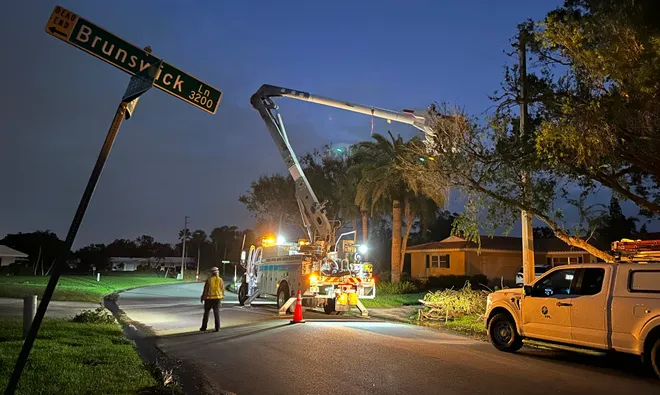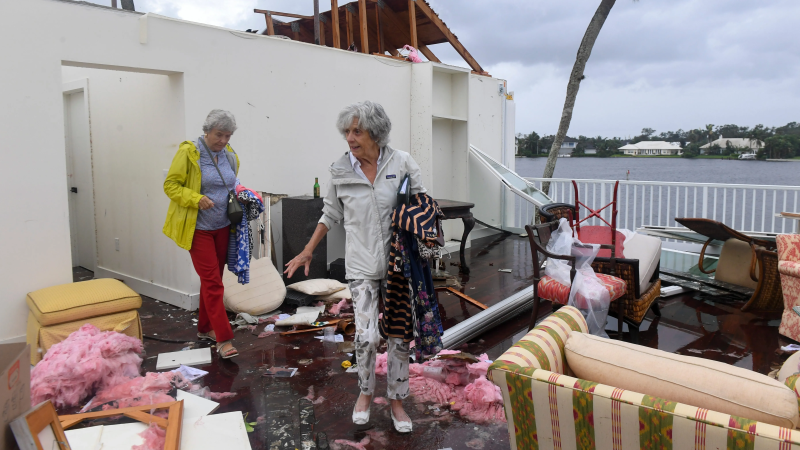Cleaning up after Milton: Floridians survey billions in damage, many still without power
Cleanup from Hurricane Milton's destruction was slow going Saturday, with roads in some counties still impassable, resources scarce for some evacuees making their way back home and power only gradually being restored.
Milton hit Florida as a Category 3 hurricane Wednesday evening and barreled east across the state, wreaking havoc before spinning out into the Atlantic. Though the Tampa Bay area was spared potentially catastrophic storm surge, Milton's pounding wind and rains left destruction in its path, and triggered deadly tornadoes far from landfall. Officials have said at least 17 people were killed across Florida. Reports of damage are still trickling in.
The White House announced Saturday that President Joe Biden approved a disaster declaration in Florida on Friday that will free up federal funding for people affected by Milton in over half of the state's counties. That includes grants for temporary housing, home repairs and loans, the White House said.
Areas only just recovering from Hurricane Helene were thrown back into chaos. Across the state, about 1.3 million homes and businesses remained without power Saturday afternoon, down from more than 2 million the day before. Those still in the dark were scrounging for ice – a commodity hard to come by – to salvage the food in their refrigerators.
In Tampa, Sarasota and St. Petersburg, residents were hopeful a major gasoline shortage in the region following Milton would ease over the weekend with the promise of fuel deliveries and the reopening of ports. Gas station after gas station with trash bagged fuel pumps greeted people with needles already on E. At the rare station with gas, lines of cars stretched nearly 2 miles down the road.
Three free fuel distribution sites opened Saturday in Plant City, Bradenton and St. Petersburg, Gov. Ron DeSantis announced. He said more would open soon, and ports were opening up to receive fuel shipments. People can get up to 10 gallons of gasoline for free each at the sites.

Some of the state's tourist hubs, including Walt Disney World and Universal Orlando reopened Friday, along with Port Canaveral for cruise and cargo traffic.
On Saturday in Flagler County, on the state's east coast, officials urged the over 130,000 residents to stay off the roads and minimize their use of running water for emergencies only because treatment plants were at capacity. There, the Florida Air National Guard was returning to distribute ready-to-eat meals Saturday.
"Avoid any downed power lines and flooded or debris-laden areas that may be hiding downed lines," the county said in an update – advice echoed to residents around the state.
STORM TRACKER:Tropical Storm Leslie weakens as next storm to form will be Nadine
Rescues teams still pulling people out of floodwaters
Search and rescue teams were still active in Hillsborough, Pinellas and Pasco counties, DeSantis said Saturday. Water continued to rise after Milton passed, so rescue crews have been working to get people to safety out of floodwaters, he said.
More than 1,000 people have been rescued from flooding and other hazards as of Saturday morning, the governor said.
"Fortunately we never had the 15- to 20- feet storm surge, but still, rising waters, very dangerous, and these guys have sprung into action," DeSantis said.
Tornadoes, winds and flooding: Milton brought widespread destruction
Milton's damage stretched well beyond its initial landfall. It hit near Siesta Key in Sarasota County, a barrier island in the Gulf of Mexico. The location of impact briefly caused "reverse" storm surge and sucked water out of Tampa Bay, averting the feared deadly storm surge that could have hit the populated area.
Still, high winds still toppled a giant crane into a downtown building and destroyed the roof of Tropicana Field, home of the Tampa Bay Rays baseball team.
As Milton roared across the state, winds were clocked at about 100 mph over 30 miles from the west coast. Tornadoes were confirmed as the storm moved east. At the Melbourne Orlando International Airport, high winds tore a giant 30-by-40 foot hole through the roof.
A large part of Polk County was left underwater. In Lake County, flooding from Milton caused nearly 2 million gallons of sewage water to spill from a wastewater treatment plant in Leesburg. Elsewhere around the state, downed trees and power lines blocked roads, winds and flooding carried vehicles and boats away and giant sinkholes opened up.
The tornadoes destroyed buildings and killed several people. In Brevard County, the roof blew off a Wells Fargo and a Supercuts was destroyed.
At least 17 killed in the storm
At least 17 people have been confirmed dead from causes related to Milton. The deaths were in St. Lucie, Volusia, Pinellas and Citrus counties, among others.
At least six were killed when tornadoes spawned by Milton tore through St. Lucie County, with the Spanish Lakes Country Club Village hit especially hard.
HIT TWICE IN A ROW:Residents on this island are upset, angry after two hurricanes
Some were killed when trees fell on their vehicles or homes, including a 79-year-old woman in Ormond Beach and a 54-year-old woman in Port Orange, both in Volusia County. Another person in Volusia died in a medical emergency when the storm prevented an immediate response.
In Hillsborough County, a woman was killed by a falling tree limb while she was outside working on her property. One man in Orange County died in the aftermath of the storm when he stepped on a downed power line Thursday evening.
Read more about those killed in Hurricane Milton.

How much will Milton's damage cost?
Early estimates suggest the damage caused by Hurricane Milton could total $50 billion, Biden said Friday. But the total cost from property damage and economic loss caused could exceed $160 billion, according to an estimate from AccuWeather, which considers impacts such as long-term health care costs to survivors and disruption to business and industries.
"Milton will go down as one of the most damaging and impactful storms in Florida history, along with Hurricane Helene’s estimated total damage and economic loss of $225-250 billion just two weeks ago," AccuWeather said.
INSURANCE PREMIUMS:How will Hurricane Milton's hit impact rates in Florida?
Since 1980, hurricanes have caused more than $1.3 trillion in damages, with each event on average bringing a cost of about $22.8 billion in damages, according to the National Oceanic and Atmospheric Administration's Office for Coastal Management.
These are the worst hurricanes in U.S. history.
(This article was updated with new information.)
Contributing: N'dea Yancey-Bragg, USA TODAY; Elena Barrera, the Tallahassee Democrat; Ana Goñi-Lessan, USA TODAY NETWORK - Florida; Frank Fernandez, the Daytona Beach News-Journal; Florida Today; Reuters
Disclaimer: The copyright of this article belongs to the original author. Reposting this article is solely for the purpose of information dissemination and does not constitute any investment advice. If there is any infringement, please contact us immediately. We will make corrections or deletions as necessary. Thank you.





